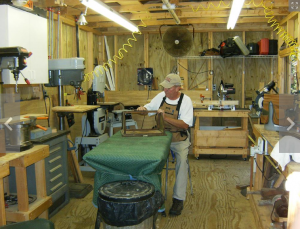What is it that should decide if an antique should or shouldn’t be refinished? One answer…….. You ! It really should come down to your own particular taste and the setting the piece is going into. Other identifying factors should involve, first and foremost the structural integrity of your piece and if it might need to have any missing pieces replaced or fabricated.
If your piece is going into a very elegant setting, it’s pretty improbable you’re going to want it to have a Shabby Chic finish on it. Conversely if your room is full of distressed vintage pieces with weather paint, a clean formal dark wood is going to stick out like a sore thumb.
Can you leave a piece of wooden furniture that has chipped or flaky paint alone……. using it just as it is? You could but here is a suggestion. Rub your hand over the surface, or use a dry rag. You’re examining for excessively deteriorating paint that is flaking off at the touch of your hand. If the chipping or flaking seems to be from normal wear and tear……then you have a couple of options. Clean your piece with an acetone rag, wearing rubber gloves. The acetone is a great way to get off old grease, ground in dirt and dust, any and all kind of stains and whatever else you’re not happy about seeing. After the cleaning you have two choices…..First – Apply a heavy coating of Bri-Wax and rub in aggressively. This will give you a smooth mellow look, not harsh or glossy. It’s also nicer to the touch. The second option is after the piece has been cleaned, now you can seal the present finish with a clear spray. A good brand of spray is Krylon, which comes in Glossy, Semi Gloss, Mat or Flat. Lot’s of options.
Another great thing to do when sealing an existing antique finish is to use 4″O” Steel Wool after the cleaning step and prior to any kind of sealant is applied. This will smooth down all the ruff edges. After using the steel wool, be sure and dust off whatever dust you’ve made, so the sealant with adhere and stick well.
The same applies to any metal objects except………rust. The distinction with anything metal, like iron beds, is that you can seal in rust…..but ultimately it will continue to rust. Just at a less advanced rate, because by spraying a clear sealant on top of an existing chipped and rusted finish, you’ve successfully lowered the rate of oxidation because the rust needs oxygen to develop. There are constantly new spray and “brush on” products which supposedly bond with the rust and completely inhibit any additional rust from happening.
advanced rate, because by spraying a clear sealant on top of an existing chipped and rusted finish, you’ve successfully lowered the rate of oxidation because the rust needs oxygen to develop. There are constantly new spray and “brush on” products which supposedly bond with the rust and completely inhibit any additional rust from happening.
But to be on the safe side, if your wanting to refinish antique iron beds, sandblasting all the old lead base paint off, is your best begin. Recreating an old rusty looking finish with chipped or weathered paint isn’t that difficult. Once again it’s you and the setting that should establish if you want your bed to look new or left in a antique state.
Bear in mind………when it comes to deciding on wether or not to refinish an old vintage or antique piece…….. there is no right or wrong…..Just what makes you happy.
I hope you’ve found this blog informative . I invite you to revisit my website
to answer any and all questions you might have about antique iron beds.
I also invite you to take a look at our company Face Book page for multiple photo albums on Custom Finishes, Canopy Conversions and a comprehensive “Before & After” King Conversions album.
Cathouse Antique Iron Be#B1BE56







